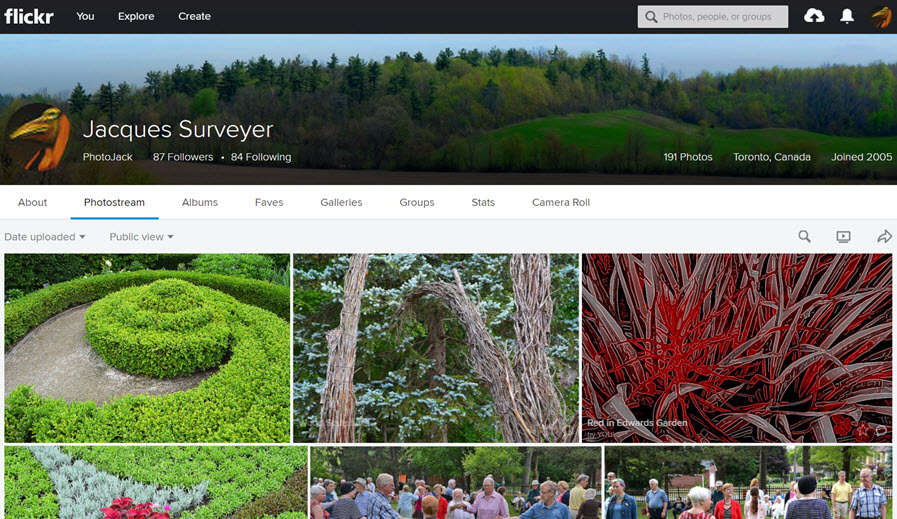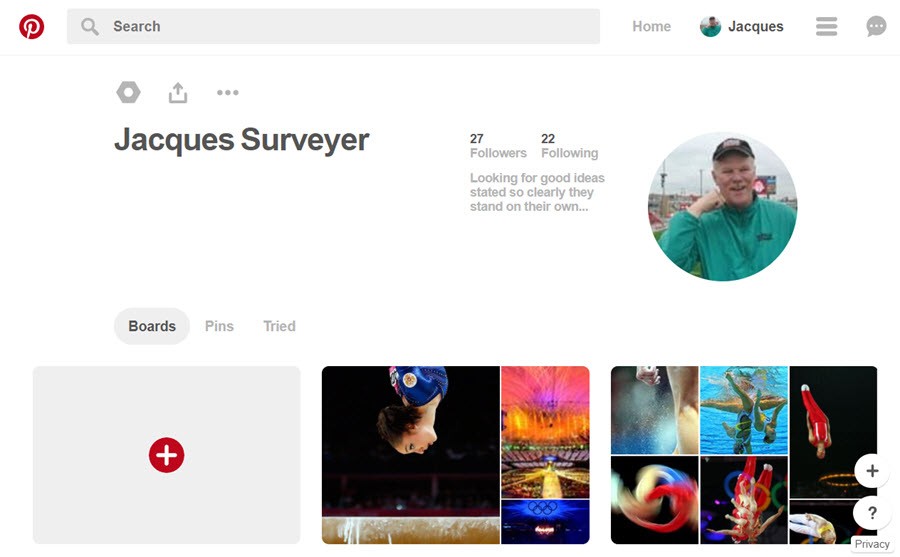As you can see from the screenshot below, this reviewer was an early user of Flickr:
What was not to like – free storage online of images grouped into categories and albums with annotations/captioning. In addition Flickr provided tools for sharing and rating colleagues photos and art work. Flickr proved popular among artists friends to show off their latest works especially since some measure of privacy was available.
Now most of the menu-items seen above were onboard Flickr way back when Facebook and Google Plus emerged with not only individual photos but also albums for display on a members social home page. But Flickr added videos and then more sharing/rating capabilities so my use of both Facebook and Google Plus for photos dwindled and flickered away. My images now appear at my own blogs, PicsofCanada.com and PixofToronto.com, or on Flickr. Flickr has over 90million registered users.
Arrival of Pinterest
So in 2010 and 2011 it was a surprise to hear all the buzz about Pinterest. Time magazine and others praised it as one of the year’s 50 best websites. What had happened? Pinterest hardly had half of Flickr’s photo and group sharing features. But Pinterest did have 3 things- an iPhone app that allowed sharing iPhone media and viewing the website; a clever icon as bookmarklet so websites could help users capture the places they liked, and an influx of capital that allowed the company to ramp up facilities and services.
So I decided to join because a)I got a mobile phone and b)I liked being able to point to websites and images with the convenient Pinterest Pin. I am still on Pinterest to highlight my own and other favorite websites:
So Pinterest managed to gain a foothold in the intensely competitive online photo album market by leading with mobile apps and simple convenience in adding to your online album. Also like Flickr, Pinterest has a generous set of free services. Other online photo tools like PhotoBucket, Fotki, SmugMug and others had higher fees, less features, or image restrictions that allowed Tumblr and DeviantArt to sprout up and survive. Pinterest currently sports 175 million active daily users using 22 languages.
Why Instagram?
If Pinterest and every other photo album website adopted mobile and tablet capable apps why did Instagram take off?
Okay, Why Snapchat ?
If your image service promises to wipe-out your story and images within a very short-time period, what is the attraction of that except to spooks and sexting teenagers? Well as of June of 2017 Snapchat had 166million active users, predominately the very valued millenials for advertisers with 20 language available. Here is one major attraction:
So What Is Going on Here?
Well each of these top online photo sharing apps [all valued in multi-billion dollars] has two common ingredients for success. First, they all have adopted the Google model – they are all substantially freeware. For example, Flickr now supplies each registered user 1TB of free space for their images and videos. Yes, Flickr does charge for extra space and a few specialized services. But like Pinterest, Instagram, Snapchat and Google for that matter, they make their money by advertising to their millions of active daily users.
The other magic ingredient is that each photo app was first to add a technical feature that contemporaries failed to take advantage of. So Flickr was first to take advantage of the astonishing drop in online storage costs and the many opensource database and operational softwares. Pinterest used bookmarklets and iPhone apps to make it simpler than Flickr to share photo interests among mobile users . Instagram one-upped Pinterest by adding customizing filters, basic video and earlier mobile support for both iOS and Android. Snapchat found a sector untouched by Instagram with simple video and story editing that could be messaged to friends and “geolocated” nearbys. In effect, each photo innovator brought features first to market that a substantial number of new mobile and online users were willing to adopt – giving substantial first entrant leads. But note how many leaders missed the next opportunity along the technical evolution trail.
Whats Coming Up in theOnline Photo & Video Space
It has already happened. There are a set of freemium online tools for graphic design and photo finishing that are of very high caliber. They are so good we have devoted separate review of 4 Graphic Design and Photo Edit tools here at ThePhotoFinishes.com. However, the interesting trend is in Online Video Editing and Conversion. Given that video file editing is complex and resource intensive and therefore not normally amenable for online processing – whazzup?? Well taking a hint from the photo gallery tools above, online video editors are using freemium services and specialty features to create viable video editing tools. Take Clipchamp for an example.
Clipchamp offers online video editing, compression and conversion services. For example Clipchamp has a free service for 5 video of 5 minutes maximum duration per month. The Business setup costs $7.50US per month allows for an ulimited number of videos of up to 30 minutes duration. In addition, the video editing capabilities include trimming, rotating, cropping, flipping and exposure adjustments. Most importantly Clipchamp offers conversions among different video types and impressive compression results as seen in the following screenshot:





